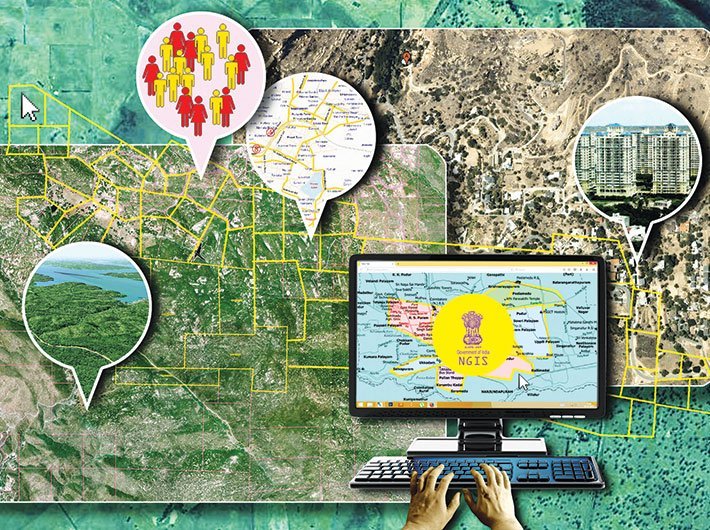Geospatial technology has manifold benefits in a variety of sectors – including better resilience to pandemic
As per the UN estimates, India’s urban population increased by 91 million in the last decade. By 2030, India is expected to be home to seven mega-cities with a population above an astounding 10 million mark. As many as 68% of the country’s total population lives in rural areas, while 17% of the urban population resides in slums. Unsurprisingly, during the pandemic it is our cities that bore the brunt of its economic and social fallouts, upsetting the pace of SDG goal target of building better and sustainable smart cities. While policies such as Smart Cities Mission, the Jawaharlal Nehru National Urban Renewal Mission, and the Atal Mission for Rejuvenation and Urban Transformation (AMRUT) are already in place to address the challenges surrounding rapid urbanization, smart planning and deployment of intelligent technologies such as electric mobility, cloud-based digital controls, transit planning, are critical to rebuild our cities.
A recent report by MEITY [India’s Trillion Dollar Digital Opportunity: Read here: https://www.meity.gov.in/writereaddata/files/india_trillion-dollar_digital_opportunity.pdf] supports the claim. It suggests that India can create up to $1 trillion of economic value from the digital economy by 2025, with half of the services, applications, content, platforms, and solutions originating in the use of emerging digital technologies. One technology that will continue to be critical in this context is geospatial technology.
Urban design and planning:
Every city has access to large amounts of valuable operational data whether it is related to urban planning, public safety, healthcare services, or traffic controls and so on, which intersects across various components of its planning and management. Moreover, since so much of planning and management is ‘location-centric’, accessing and understanding the location-related data is critical and can drive easy and intelligent mobility- one of the foundations on which a smart city is built. A use case in point is when photos and information captured via smart cameras and sensors on traffic junctions are used to monitor traffic, manage road safety, as well as inform city-planning.
Geo-fencing technology and consumer spatial data collected from smartphones and mobile apps can help urban designers and planners to recognize movement and model ways in which people move, walk, and run. This data can be used to create green spaces, build roads, bridges, walking routes, bifurcate residential, tourist and industrial areas thus making life more comfortable and safer for its residents.
Waste management:
One of the critical challenges cities face today is that of trash piling on urban man-made landfills. Of the total waste generated daily, only a fraction of it is treated and landfilled. As environmental sustainability becomes mainstream, municipal authorities and garbage managers will have to up their waste management and recycling game. Using HD maps, fleet trackers and advanced fleet management suites can help authorities in dispatching of, distribution and collection of waste, route optimization for garbage collection trucks and improve citizen satisfaction.
Emergency response and public safety:
The data gathered from all remote spatial technologies can be leveraged to quickly narrow down relevant information about citizen distress and take preventive steps required to enhance public safety at any given point in time. Uttar Pradesh is home to the largest police force in the world, looking after a population of 200 million people. Using real-time tracking location, GPS positioning and geofencing systems, the police personnel can send dispatches in 11 different languages, including turn-by-turn instructions with voice guidance, giving the police the fastest route possible to reach citizens in distress.
Citizen services:
Data gathered by a wide range of devices – right from smartphone apps, cameras and sensors embedded in cars, televisions, traffic signals to buildings –- can help governments plan and pursue new models of delivering public utility services. Spatial data can provide insights into the functioning of government agencies, understand citizen attitudes and preferences to devise innovative solutions for the most pressing challenges. For example, in Haryana, the local administration deployed 24 satellites and drones to prepare a digital map, with geo-referencing to create ownership records of every piece of property. This resulted in the resolution of several land records and for over 2,800 acres, comprising of 1,500 issues that were resolved. This is now being replicated in the states of Karnataka and Maharashtra, where satellite imagery is being used for land planning and utilization of water resources, etc.
Healthcare:
In healthcare, one of the key components driving customer service and satisfaction is to enable first responders to act with accurate geospatial information, thereby reducing the time taken to attend to the person in distress. Using location-based solutions, healthcare authorities can track ambulances on the go, make quick on-the-spot decisions about the treatment plan, and dispatch medical units to a person in distress. Alternatively, attendants and families of patients can use indoor maps, to navigate through parking spaces around health facilities, conveniently check-in and schedule appointments and locate specialized staff throughout an area, thus simplifying and enhancing their experience.
Beyond the devices that connect one another if we focus on human needs in a spatial context, we can redefine this tripartite relationship between our physical environments, governments, and citizens. With human-centric values at its core, location data can help redefine policymaking basics, empower public service officials and the community to work together to transform our current cities into the ones that create economic and business opportunities, safe and affordable housing, and resilient communities.
Ankush Chatterjee is Head of Product Portfolio Management, APAC, HERE Technologies.
